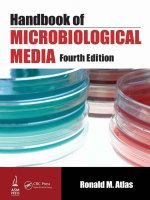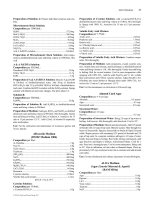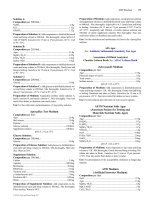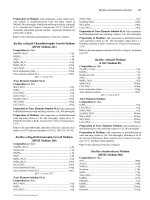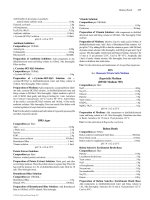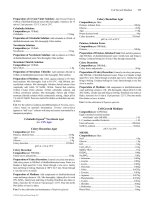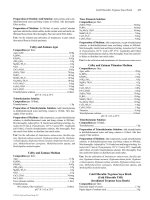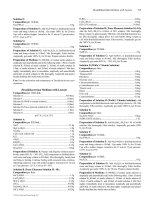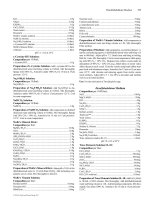Handbook of Microbiological Media, Fourth Edition part 10 ppt
Bạn đang xem bản rút gọn của tài liệu. Xem và tải ngay bản đầy đủ của tài liệu tại đây (227.99 KB, 10 trang )
ALOA Medium 85
Preparation of Solution A: Prepare individual solutions and com-
bine.
Microelements Stock Solution:
Composition
per 1090.0mL:
H
3
BO
3
572.0mg
MnCl
2
·4H
2
O 360.0mg
ZnSO
4
·7H
2
O 44.0mg
MoO
3
36.0mg
CuSO
4
·5H
2
O 15.8mg
CoCl
2
·6H
2
O 8.0mg
NH
4
VO
3
4.6mg
A & A FeEDTA solution 160.0mL
Preparation of Microelements Stock Solution: Add compo-
nents to distilled/deionized water and bring volume to 1090.0mL. Mix
well.
A & A FeEDTA Solution:
Composition
per 550.0mL:
Disodium EDTA·2H
2
O 20.4g
FeSO
4
·7H
2
O 13.7g
KOH 5.2g
Preparation of A & A FeEDTA Solution: Dissolve 5.2g of KOH
in 186.0mL of distilled/deionized water. Add 20.4g of disodium
EDTA·2H
2
O. Add 13.7g of FeSO4·7H2O to 364.0mL of distilled/deion-
ized water. Combine the EDTA solution with the FeSO
4
solution. Sparge
solution with filtered air until color changes. The pH is about 3.5.
Solution B:
Composition
per 500.0mL:
K
2
HPO
4
28.0g
Preparation of Solution B: Add K
2
HPO
4
to distilled/deionized
water and bring volume to 500.0mL.
Preparation of Medium: Add agar, KNO
3
, and NaNO
3
to distilled/
deionized water and bring volume to 969.0mL. Mix thoroughly. Gently
heat and bring to boiling. Add 25.0mL of solution A. Autoclave for 15
min at 15 psi pressure–121°C.
Add 6.25mL of solution B aseptically
after sterilization.
Use: For the cultivation and maintenance of Anabaena species and
Nostoc species.
Allisonella Medium
(DSMZ Medium 1006)
Composition per liter:
DL-Histidine 7.8g
Na
2
CO
3
4.0g
Yeast extract 4.0g
Trypticase 1.0g
(NH
4
)
2
SO
4
480.0mg
NaCl 480.0mg
K
2
HPO
4
292.0mg
KH
2
PO
4
292.0mg
MgSO
4
·7H
2
O 100.0mg
CaCl
2
·2H
2
O 64.0mg
Resazurin 1.0mg
Cysteine solution 10.0mL
Volatile fatty acid mixture 3.1mL
pH 6.0 ± 0.2 at 25°C
Cysteine Solution:
Composition
per 10.0mL:
L-Cysteine·HCl·H
2
O 0.5g
Preparation of Cysteine Solution: Add L-cysteine·HCl·H
2
O to
distilled/deionized water and bring volume to 10.0mL. Mix thorough-
ly. Sparge with 100% N
2
. Autoclave for 15 min at 15 psi pressure–
121°C.
Volatile Fatty Acid Mixture:
Composition
per 7.75mL:
Acetic acid 4.25mL
Propionic acid 1.50mL
Butyric acid 1.0mL
DL-2-Methyl butyric acid 0.25mL
iso-Butyric acid 0.25mL
iso-Valeric acid 0.25mL
n-Valeric acid 0.25mL
Preparation of Volatile Fatty Acid Mixture: Combine compo-
nents. Mix thoroughly.
Preparation of Medium: Add components, except cysteine solu-
tion, volatile fatty acid mixture, and bicarbonate, to distilled/deionized
water and bring volume to 1.0L. Mix thoroughly. Gently heat and bring
to boiling. Boil for several minutes. Cool to room temperature while
sparging with 100% CO
2
. Add the solid Na
2
CO
3
and 3.1 mL volatile
fatty acid mixture and 10.0mL cysteine solution. Adjust the pH to 6.0.
Distribute into serum bottles or Hungate tubes under 100% CO
2
. Au-
toclave for 15 min at 15 psi pressure–121°C.
Use: For the maintenance or cultivation of Allisonella spp.
Almond Curd Agar
Composition per 4–6 servings:
Almonds 0.5 pound
Agar 0.5 cup
Sweetened water 2.0 cups
Sweetened Water:
Composition
per 2.0 cups:
Sucrose 0.5 cup
Preparation of Sweetened Water: Bring 2.0 cups of tap water to
boiling. Add sucrose. Mix thoroughly until dissolved. Cool to 4°C.
Preparation of Medium: Blanch and skin almonds. Add 0.25 pound
in blender with 2.0 cups of tap water. Blend to a paste. Filter through two
layers of cheesecloth. Squeeze cheesecloth to obtain all liquid. Discard
solids. Repeat process with remaining 0.25 pound of almonds and 2.0
cups of tap water. In a separate container add agar to 3.0 cups of water.
Gently heat and bring to boiling. Boil while stirring continuously until
agar dissolves and begins to thicken. Add almond filtrate. Cook for 1
min. Pour into a rectangular pan. Cool to room temperature. Bring curd
to 4°C. Prior to utilization, cut into cubes or diamond shapes. Place ap-
proximately 0.25 cup sweetened water into a container and add almond
curd cubes.
Use: For the refreshment and culinary enjoyment of microbiologists.
ALOA Medium
(Agar Listeria Ottavani & Agosti)
(BAM M10a)
Composition per liter:
Agar 18.0g
Peptone 18.0g
LiCl 10.0g
Yeast extract 10.0g
Tryptone 6.0g
NaCl 5.0g
© 2010 by Taylor and Francis Group, LLC
86 ALOA Medium
Na
2
HPO
4
2.5g
Na-pyruvate 2.0g
Glucose 2.0g
Mg-glycerophosphate 1.0g
MgSO
4
0.5g
5-Bromo4-chloro-indolyl-β-
D-glucopyranoside 0.05g
Phosphatidylinositol solution 50.0mL
Nalidixic acid solution 5.0mL
Ceftazidime solution 5.0mL
Cycloheximide solution 5.0mL
Polymyxin B solution 5.0mL
pH 7.2 ± 0.2 at 25°C
Nalidixic Acid Solution:
Composition
per 5.0mL:
Nalidixic acid 0.02g
Preparation of Nalidixic Acid Solution: Add nalidixic acid to
distilled/deionized water and bring volume to 5.0mL. Mix thoroughly.
Filter sterilize.
Ceftazidime Solution:
Composition
per 5.0mL:
Ceftazidime 0.02g
Preparation of Ceftazidime Solution: Add ceftazidime to dis-
tilled/deionized water and bring volume to 5.0mL. Mix thoroughly. Fil-
ter sterilize.
Cycloheximide Solution:
Composition
per 5.0mL:
Cycloheximide 0.05g
Ethanol 2.5mL
Preparation of Cycloheximide Solution: Add cycloheximide to
2.5mL of ethanol. Mix thoroughly. Bring volume to 5.0mL with dis-
tilled/deionized water. Filter sterilize.
Caution: Cycloheximide is toxic. Avoid skin contact or aerosol for-
mation and inhalation.
Polymyxin B Solution:
Composition
per 5.0mL:
Polymyxin B 76700U
Preparation of Polymyxin B Solution: Add polymyxin B to dis-
tilled/deionized water and bring volume to 5.0mL. Mix thoroughly. Fil-
ter sterilize.
Phosphatidylinositol Solution:
Composition
per 50.0mL:
L-α-phosphatidylinositol 2.0g
Preparation of Phosphatidylinositol Solution: Add L-α-phos-
photidylinositol to cold distilled/deionized water and bring volume to
50.0mL. Stir for 30 min so a homogeneous suspension is obtained. Au-
toclave for 15 min at 15 psi pressure–121°C. Cool to 48–50°C.
Preparation of Medium: Add components, except phosphati-
dylinositol solution, nalidixic acid solution, cetazidime solution, cyclo-
heximide solution, and polymyxin B solution, to distilled/deionized
water and bring volume to 930.0mL. Mix thoroughly. Adjust the pH to
7.2. Gently heat and bring to boiling. Autoclave for 15 min at 15 psi
pressure–121°C. Cool to 45°–50°C. Aseptically add 50.0mL sterile
phosphatidylinositol solution, 5.0mL sterile nalidixic acid solution,
5.0mL sterile cetazidime solution, 5.0mL sterile cycloheximide solu-
tion, and 5.0mL sterile polymyxin B solution. Mix thoroughly. Pour
into Petri dishes or distribute into sterile tubes.
Use: For the isolaltion and cultivation of Listeria spp.
ALOA Medium
(Agar Listeria Ottavani & Agosti)
(BAM M10a)
Composition per liter:
Agar 18.0g
Peptone 18.0g
LiCl 10.0g
Yeast extract 10.0g
Tryptone 6.0g
NaCl 5.0g
Na
2
HPO
4
2.5g
Na-pyruvate 2.0g
Glucose 2.0g
Mg-glycerophosphate 1.0g
MgSO
4
0.5g
5-Bromo4-chloro-indolyl-β-
D-glucopyranoside 0.05g
Phosphatidylinositol solution 50.0mL
Amphotericin B solution 10.0mL
Nalidixic acid solution 5.0mL
Ceftazidime solution 5.0mL
Polymyxin B solution 5.0mL
pH 7.2 ± 0.2 at 25°C
Nalidixic Acid Solution:
Composition
per 5.0mL:
Nalidixic acid 0.02g
Preparation of Nalidixic Acid Solution: Add nalidixic acid to
distilled/deionized water and bring volume to 5.0mL. Mix thoroughly.
Filter sterilize.
Ceftazidime Solution:
Composition
per 5.0mL:
Ceftazidime 0.02g
Preparation of Ceftazidime Solution: Add ceftazidime to dis-
tilled/deionized water and bring volume to 5.0mL. Mix thoroughly. Fil-
ter sterilize.
Amphotericin B Solution:
Composition
per 10.0mL:
Amphotericin B 0.01g
Dimethylforamide 7.5mL
HCL, 1M 2.5mL
Preparation of Amphotericin B Solution: Add amphotericin B
to 2.5mL of 1M HCl. Mix thoroughly. Add 7.5 mL of dimethlyfor-
amide. Mix thoroughly. Filter sterilize.
Polymyxin B Solution:
Composition
per 5.0mL:
Polymyxin B 76700U
Preparation of Polymyxin B Solution: Add polymyxin B to dis-
tilled/deionized water and bring volume to 5.0mL. Mix thoroughly. Fil-
ter sterilize.
Phosphatidylinositol Solution:
Composition
per 50.0mL:
L-α-phosphatidylinositol 2.0g
Preparation of Phosphatidylinositol Solution: Add L-α-phos-
photidylinositol to cold distilled/deionized water and bring volume to
50.0mL. Stir for 30 min so a homogeneous suspension is obtained. Au-
toclave for 15 min at 15 psi pressure–121°C. Cool to 48–50°C.
Preparation of Medium: Add components, except phosphati-
dylinositol solution, nalidixic acid solution, cetazidime solution, am-
© 2010 by Taylor and Francis Group, LLC
Alteromonas denitrificans Medium 87
photericin B solution, and polymyxin B solution, to distilled/deionized
water and bring volume to 920.0mL. Mix thoroughly. Adjust the pH to
7.2. Gently heat and bring to boiling. Autoclave for 15 min at 15 psi
pressure–121°C. Cool to 45°–50°C. Aseptically add 50.0mL sterile
phosphatidylinositol solution, 5.0mL sterile nalidixic acid solution,
5.0mL sterile cetazidime solution, 10.0mL sterile amphotericin B solu-
tion, and 5.0mL sterile polymyxin B solution. Mix thoroughly. Pour
into Petri dishes or distribute into sterile tubes.
Use: For the isolaltion and cultivation of Listeria spp. For the isolation
and cultivation of Literia spp. according to ISO standard 11290.
ALP Basal Medium
(Aerobic Low Peptone Basal Medium)
Composition per liter:
Agar 15.0g
(NH
4
)
2
SO
4
1.0g
Pancreatic digest of casein 0.5g
Yeast extract 0.5g
MgSO
4
·7H
2
O 0.2g
KCl 0.2g
Phenol Red 0.02g
Substrate solution 50.0mL
pH 7.8 ± 0.2 at 25°C
Substrate Solution:
Composition
per 50.0mL:
Substrate 0.1g
Preparation of Substrate Solution: Add substrate to distilled/de-
ionized water and bring volume to 50.0mL. Use sugars, carbohydrates,
n-butanol, other alcohols, or any acidogenic carbon source. Mix thor-
oughly. Filter sterilize.
Preparation of Medium: Add components, except substrate solu-
tion, to distilled/deionized water and bring volume to 950.0mL. Mix
thoroughly. Gently heat and bring to boiling. Adjust pH to 7.8. Distrib-
ute into screw-capped tubes in 3.0mL volumes. Autoclave for 15 min
at 15 psi pressure–121°C. Cool to 45°–50°C. Aseptically add 0.15mL
of sterile substrate solution to each tube. Mix thoroughly. Allow tubes
to cool in a slanted position.
Use: For the cultivation and differentiation of microorganisms based
on their ability to utilize a variety of carbon sources such as carbohy-
drates, alcohols, and other acidogenic substrates.
ALP Basal Medium Low pH
(Aerobic Low Peptone Basal Medium)
Composition per liter:
Agar 15.0g
(NH
4
)
2
SO
4
1.0g
Pancreatic digest of casein 0.5g
Yeast extract 0.5g
Glucose 0.2g
MgSO
4
·7H
2
O 0.2g
KCl 0.2g
Phenol Red 0.02g
Substrate solution 50.0mL
pH 6.5 ± 0.2 at 25°C
Substrate Solution:
Composition
per 50.0mL:
Substrate 0.1g
Preparation of Substrate Solution: Add substrate to distilled/de-
ionized water and bring volume to 50.0mL. Use gelatin, aliphatic acids,
or any alkalogenic carbon source. Mix thoroughly. Filter sterilize.
Preparation of Medium: Add components, except substrate solu-
tion, to distilled/deionized water and bring volume to 950.0mL. Mix
thoroughly. Gently heat and bring to boiling. Adjust pH to 6.5. Distrib-
ute into screw-capped tubes in 3.0mL volumes. Autoclave for 15 min
at 15 psi pressure–121°C. Cool to 45°–50°C. Aseptically add 0.15mL
of sterile substrate solution to each tube. Mix thoroughly. Allow tubes
to cool in a slanted position.
Use: For the cultivation and differentiation of microorganisms based
on their ability to utilize a variety of carbon sources such as gelatin, ali-
phatic acids, and other alkalophilic substrates.
Alternative Thioglycollate Medium
(NIH Thioglycollate Broth)
Composition per liter:
Casein enzymatic hydrolysate 15.0g
Glucose 5.5g
Yeast extract 5.0g
NaCl 2.5g
L-Cystine 0.5g
Sodium thioglycollate 0.5g
pH 7.1 ± 0.1 at 25°C
Source: This medium is available from HiMedia.
Preparation of Medium: Add components to distilled/deionized
water and bring volume to 1.0L. Mix thoroughly. Distribute into tubes
or flasks. Autoclave for 10 min at 15 psi pressure–121°C.
Use: For the sterility testing of certain biological products that are tur-
bid or viscous.
Alternative Thioglycollate Medium
Composition per liter:
Plant hydrolysate 15.0g
Glucose 5.5g
Yeast extract 5.0g
NaCl 2.5g
L-Cystine 0.5g
Sodium thioglycollate 0.5g
pH 7.1 ± 0.1 at 25°C
Source: This medium is available from HiMedia.
Preparation of Medium: Add components to distilled/deionized
water and bring volume to 1.0L. Mix thoroughly. Distribute into tubes
or flasks. Autoclave for 10 min at 15 psi pressure–121°C.
Use: For the sterility testing of certain biological products that are tur-
bid or viscous.
Alteromonas denitrificans Medium
Composition per liter:
Peptone 0.5g
Pancreatic digest of casein 0.5g
Yeast extract 0.5g
Aged seawater 800.0mL
Preparation of Medium: Add components, except aged seawater,
to tap water and bring volume to 200.0mL. Mix thoroughly. Autoclave
for 15 min at 15 psi pressure–121°C. Aseptically add 800.0mL of fil-
ter-sterilized aged seawater. Mix thoroughly. Aseptically distribute
into sterile tubes or flasks.
© 2010 by Taylor and Francis Group, LLC
88 Alteromonas Medium
Use: For the cultivation of Alteromonas denitrificans.
Alteromonas Medium
(LMG Medium 28)
Composition per 1012mL:
Agar base 1.0L
Methanol 10.0mL
Solution A 1.0mL
Solution B 1.0mL
pH 7.0± 0.2 at 25°C
Agar Base:
Composition
per liter:
NaCl 20.0g
Agar 15.0g
(NH
4
)
2
SO
4
2.0g
K
2
HPO
4
2.0g
KH
2
PO
4
1.0g
MgSO
4
·7H
2
O 0.3g
Preparation of Agar Base: Add components to 1.0L of distilled/de-
ionized water. Mix thoroughly.
Solution A:
Composition
per 100.0mL:
MnSO
4
·2H
2
O 76mg
FeSO
4·
7H
2
O 28mg
CuSO
4
·5H
2
O 25mg
Na
2
MoO
4
·2H
2
O 24mg
CoCl
2
·6H
2
O 24mg
CaCl
2
·2H
2
O 15mg
ZnSO
4
·7H
2
O 0.14mg
Preparation of Solution A: Add components to 100.0mL of dis-
tilled/deionized water. Mix thoroughly.
Solution B:
Composition
per 100.0mL:
Vitamin B
12
0.1mg
Preparation of Solution B: Add Vitamin B
12
to 100.0mL of dis-
tilled/deionized water. Mix thoroughly. Filter sterilize.
Preparation of Medium: Add 1.0mL Solution A to 1.0L Agar Base.
Mix thoroughly. Adjust pH to 7.0. Gently heat and bring to boiling. Au-
toclave for 15 min at 15 psi pressure–121°C. Cool to 45°–50°C. Asepti-
cally add 1.0mL sterile Solution B and 10.0mL filter-sterilized methanol.
Mix thoroughly. Pour into sterile Petri dishes or distribute into sterile
tubes.
Use: For the cultivation of Alteromonas spp.
AMB Agar
Composition per liter:
Agar 15.0g
Starch, soluble 5.0g
Pancreatic digest of casein 2.5g
MgSO
4
·7H
2
O 0.5g
K
2
HPO
4
0.25g
Preparation of Medium: Add components to distilled/deionized
water and bring volume to 1.0L. Mix thoroughly. Gently heat and bring
to boiling. Distribute into tubes or flasks. Autoclave for 15 min at 15
psi pressure–121°C. Pour into sterile Petri dishes or leave in tubes.
Use: For the cultivation of myxobacteria.
AMB Broth
Composition per liter:
Starch, soluble 5.0g
Pancreatic digest of casein 2.5g
MgSO
4
·7H
2
O 0.5g
K
2
HPO
4
0.25g
Preparation of Medium: Add components to distilled/deionized
water and bring volume to 1.0L. Mix thoroughly. Distribute into tubes
or flasks. Autoclave for 15 min at 15 psi pressure–121°C.
Use: For the cultivation of myxobacteria.
AMB Medium
Composition per liter:
Meat infusion 25.0g
K
2
HPO
4
15.0g
Glucose 5.0g
Yeast extract 5.0g
Pancreatic digest of casein 4.0g
L-Cysteine 1.0g
(NH
4
)
2
SO
4
1.0g
Starch, soluble 1.0g
MgSO
4
0.2g
CaCl
2
0.01g
pH 6.9 ± 0.2 at 25°C
Preparation of Medium: Add components to distilled/deionized
water and bring volume to 1.0L. Mix thoroughly. Gently heat and bring
to boiling. Distribute into tubes or flasks. Autoclave for 15 min at 15
psi pressure–121°C.
Use: For the cultivation and maintenance of Eubacterium alactolyti-
cum, Eubacterium budayl, Eubacterium moniliforme, and Eubacte-
rium tortuosum.
American Association of Textile Chemists and Colorists
Bacteriostasis Agar
See: AATCC Bacteriostasis Agar
American Association of Textile Chemists and Colorists
Bacteriostasis Broth
See: FDA Broth
American Association of Textile Chemists and Colorists
Mineral Salts Iron Agar
See: AATCC Mineral Salts
Iron Agar
American Society for Testing
and Materials Nutrient Salts Agar
See: ASTM Nutrient Salts Agar
American Trudeau Society Medium
See: ATS Medium
AMH
(DSMZ Medium 1110)
Composition per liter:
NaCl 20.0g
Sulfur, powdered 5.0g
© 2010 by Taylor and Francis Group, LLC
Amies Modified Transport Medium with Charcoal 89
MgCl
2
·6H
2
O 3.0g
KCl 0.5g
NH
4
Cl 0.25g
KH
2
PO
4
0.2g
CaCl
2
·2H
2
O 0.15g
Resazurin 0.5mg
Vitamin solution 10.0mL
Na
2
S·9H
2
O solution 10.0mL
NaHCO
3
solution 10.0mL
Trace elements solution SL-10 1.0mL
Selenite-tungstate solution 1.0mL
pH 7.0 ± 0.2 at 25°C
NaHCO
3
Solution:
Composition per 10.0mL:
NaHCO
3
2.5g
Preparation of NaHCO
3
Solution: Add NaHCO
3
to distilled/de-
ionized water and bring volume to 10.0mL. Mix thoroughly. Sparge
with 20% CO
2
+ 80% H
2
. Autoclave for 15 min at 15 psi pressure–
121°C. Cool to room temperature.
Na
2
S·9H
2
O Solution:
Composition per 10.0mL:
Na
2
S·9H
2
O 0.5g
Preparation of Na
2
S·9H
2
O Solution: Add Na
2
S·9H
2
O to dis-
tilled/deionized water and bring volume to 10.0mL. Mix thoroughly.
Autoclave under 100% N
2
for 15 min at 15 psi pressure–121°C. Cool
to room temperature.
Vitamin Solution:
Composition
per liter:
Pyridoxine-HCl 10.0mg
Thiamine-HCl·2H
2
O 5.0mg
Riboflavin 5.0mg
Nicotinic acid 5.0mg
D-Ca-pantothenate 5.0mg
p-Aminobenzoic acid 5.0mg
Lipoic acid 5.0mg
Biotin 2.0mg
Folic acid 2.0mg
Vitamin B
12
0.1mg
Preparation of Vitamin Solution: Add components to distilled/
deionized water and bring volume to 1.0L. Mix thoroughly. Sparge
with 80% H
2
+ 20% CO
2
. Filter sterilize.
Selenite/Tungstate Solution:
Composition
per liter:
NaOH 0.5g
Na
2
WO
4
·2H
2
O 4.0mg
Na
2
SeO
3
·5H
2
O 3.0mg
Preparation of Selenite/Tungstate Solution: Add components
to distilled/deionized water and bring volume to 1.0L. Mix thoroughly.
Sparge with 100% N
2
. Autoclave for 15 min at 15 psi pressure–121°C.
Trace Elements Solution SL-10:
Composition
per liter:
FeCl
2
·4H
2
O 1.5g
CoCl
2
·6H
2
O 190.0mg
MnCl
2
·4H
2
O 100.0mg
ZnCl
2
70.0mg
Na
2
MoO
4
·2H
2
O 36.0mg
NiCl
2
·6H
2
O 24.0mg
H
3
BO
3
6.0mg
CuCl
2
·2H
2
O 2.0mg
HCl (25% solution) 10.0mL
Preparation of Trace Elements Solution SL-10: Add FeCl
2
·4H
2
O
to 10.0mL of HCl solution. Mix thoroughly. Add distilled/deionized
water and bring volume to 1.0L. Add remaining components. Mix thor-
oughly. Sparge with 100% N
2
. Autoclave for 15 min at 15 psi pressure–
121°C.
Preparation of Medium: Add components, except bicarbonate so-
lution, sulfide solution, sulfur, and vitamin solution, to distilled/deion-
ized water and bring volume to 970.0mL. Mix thoroughly. Gently heat
and bring to boiling. Boil for several minutes. Cool to room tempera-
ture while sparging with 80% H
2
+ 20% CO
2
. Add the bicarbonate so-
lution, sulfide solution, and vitamin solution. Distribute into scew-
capped tubes or bottles. Autoclave for 15 min at 15 psi pressure–
121°C. Place the sulfur in screw-capped tubes or bottles. Autoclave for
15 min at 8 psi pressure–112°C. Before use, aseptically and anoxically
layer the sulfur onto the surface of sterile liquid basal medium. Adjust
the final pH to 7.0. After inoculation, pressurize culture vials to 1 bar
overpressure with 80% H
2
and 20% CO
2
gas mixture.
Use: For the maintenance or cultivation of Nautilia profundicola.
Amies Modified Transport Medium with Charcoal
Composition per liter:
Charcoal 10.0g
Agar 4.0g
NaCl 3.0g
Na
2
HPO
4
1.15g
Sodium thioglycolate 1.0g
KCl 0.2g
KH
2
PO
4
0.2g
CaCl
2
·2H
2
O 0.1g
MgCl
2
·6H
2
O 0.1g
pH 7.2 ± 0.2 at 25°C
Source: This medium is available as a premixed powder from BD Di-
agnostic Systems.
Preparation of Medium: Add components to distilled/deionized
water and bring volume to 1.0L. Mix thoroughly. Gently heat and bring
to boiling. Distribute into flasks or tubes. Autoclave for 20 min at 15
psi pressure–121°C. While cooling, turn tubes to uniformly suspend
charcoal.
Use: For the transport of swab specimens to prolong the survival of
microorganisms, especially Neisseria gonorrhoeae, between collec-
tion and culturing. Addition of charcoal to this medium neutralizes
metabolic products that may be toxic to Neisseria gonorrhoeae.
Amies Modified Transport Medium with Charcoal
Composition per liter:
Charcoal 10.0g
NaCl 8.0g
Agar 3.6g
Na
2
HPO
4
1.15g
Sodium thioglycolate 1.0g
KCl 0.2g
CaCl
2
·2H
2
O 0.1g
MgCl
2
·6H
2
O 0.1g
KH
2
PO
4
0.2g
pH 7.2 ± 0.2 at 25°C
© 2010 by Taylor and Francis Group, LLC
90 Amies Transport Medium without Charcoal
Source: This medium is available as a premixed powder from BD Di-
agnostic Systems and Oxoid Unipath.
Preparation of Medium: Add components to distilled/deionized
water and bring volume to 1.0L. Mix thoroughly. Gently heat and bring
to boiling. Distribute into flasks or tubes. Autoclave for 20 min at 15
psi pressure–121°C. While cooling, turn tubes to uniformly suspend
charcoal.
Use: For the transport of swab specimens to prolong the survival of
microorganisms, especially Neisseria gonorrhoeae, between collection
and culturing. Addition of charcoal to this medium neutralizes metabolic
products that may be toxic to Neisseria gonorrhoeae.
Amies Transport Medium without Charcoal
Composition per liter:
Agar 4.0g
NaCl 3.0g
Na
2
HPO
4
1.15g
Sodium thioglycolate 1.0g
KCl 0.2g
CaCl
2
·2H
2
O 0.1g
MgCl
2
·6H
2
O 0.1g
KH
2
PO
4
0.2g
pH 7.2 ± 0.2 at 25°C
Source: This medium is available as a premixed powder from BD Di-
agnostic Systems.
Preparation of Medium: Add components to distilled/deionized
water and bring volume to 1.0L. Mix thoroughly. Gently heat and bring
to boiling. Distribute into flasks or tubes. Autoclave for 20 min at 15
psi pressure–121°C.
Use: For the transport of swab specimens to prolong the survival of
microorganisms, especially Neisseria gonorrhoeae, between collec-
tion and culturing.
Amies Transport Medium without Charcoal
Composition per liter:
NaCl 8.0g
Agar 3.6g
Na
2
HPO
4
1.15g
Sodium thioglycolate 1.0g
KCl 0.2g
CaCl
2
·2H
2
O 0.1g
MgCl
2
·6H
2
O 0.1g
KH
2
PO
4
0.2g
pH 7.2 ± 0.2 at 25°C
Source: This medium is available as a premixed powder from BD Di-
agnostic Systems.
Preparation of Medium: Add components to distilled/deionized
water and bring volume to 1.0L. Mix thoroughly. Gently heat and bring
to boiling. Distribute into flasks or tubes. Autoclave for 20 min at 15
psi pressure–121°C.
Use: For the transport of swab specimens to prolong the survival of
microorganisms, especially Neisseria gonorrhoeae, between collec-
tion and culturing.
Aminiphilus Medium
(DSMZ Medium 1082)
Composition per liter:
Trypticase peptone 10.0g
Casamino acids 10.0g
NaCl 1.0g
KCl 0.5g
MgCl
2
·6H
2
O 0.4g
NH
4
Cl 0.3g
KH
2
PO
4
0.2g
CaCl
2
·2H
2
O 0.15g
Resazurin 0.5mg
NaHCO
3
solution 10.0mL
Vitamin solution 10.0mL
Na
2
S·9H
2
O solution 10.0mL
Trace elements solution SL-10 1.0mL
pH 7.1 ± 0.2 at 25°C
NaHCO
3
Solution:
Composition per 10.0mL:
NaHCO
3
2.5g
Preparation of NaHCO
3
Solution: Add NaHCO
3
to distilled/de-
ionized water and bring volume to 10.0mL. Mix thoroughly. Sparge
with 20% CO
2
+ 80% H
2
. Autoclave for 15 min at 15 psi pressure–
121°C. Cool to room temperature.
Na
2
S·9H
2
O Solution:
Composition per 100.0mL:
Na
2
S·9H
2
O 0.6g
Preparation of Na
2
S·9H
2
O Solution: Add Na
2
S·9H
2
O to dis-
tilled/deionized water and bring volume to 100.0mL. Mix thoroughly.
Autoclave under 100% N
2
for 15 min at 15 psi pressure–121°C. Cool
to room temperature.
Vitamin Solution:
Composition
per liter:
Pyridoxine-HCl 10.0mg
Thiamine-HCl·2H
2
O 5.0mg
Riboflavin 5.0mg
Nicotinic acid 5.0mg
D-Ca-pantothenate 5.0mg
p-Aminobenzoic acid 5.0mg
Lipoic acid 5.0mg
Biotin 2.0mg
Folic acid 2.0mg
Vitamin B
12
0.1mg
Preparation of Vitamin Solution: Add components to distilled/
deionized water and bring volume to 1.0L. Mix thoroughly. Sparge
with 80% H
2
+ 20% CO
2
. Filter sterilize.
Trace Elements Solution SL-10:
Composition
per liter:
FeCl
2
·4H
2
O 1.5g
CoCl
2
·6H
2
O 190.0mg
MnCl
2
·4H
2
O 100.0mg
ZnCl
2
70.0mg
Na
2
MoO
4
·2H
2
O 36.0mg
NiCl
2
·6H
2
O 24.0mg
H
3
BO
3
6.0mg
CuCl
2
·2H
2
O 2.0mg
HCl (25% solution) 10.0mL
Preparation of Trace Elements Solution SL-10: Add FeCl
2
·4H
2
O
to 10.0mL of HCl solution. Mix thoroughly. Add distilled/deionized
water and bring volume to 1.0L. Add remaining components. Mix thor-
oughly. Sparge with 100% N
2
. Autoclave for 15 min at 15 psi pressure–
121°C.
© 2010 by Taylor and Francis Group, LLC
Ammonifex Medium 91
Preparation of Medium: Add components, except Na
2
S·9H
2
O so-
lution, bicarbonate solution, and vitamin solution, to distilled/deion-
ized water and bring volume to 970.0mL. Mix thoroughly. Gently heat
and bring to boiling. Boil for several minutes. Cool to room tempera-
ture while sparging with 20% CO
2
+ 80% N
2
. Dispense into tubes or
flasks. Autoclave for 15 min at 15 psi pressure–121°C. Cool to 25°C.
Aseptically and anoxically add the Na
2
S·9H
2
O solution, bicarbonate
solution, and vitamin solution. The pH should be 7.1.
Use: For the maintenance or cultivation of Aminiphilus spp.
Amino Acid Assay Medium
Composition per liter:
Glucose 50.0g
Sodium acetate 40.0g
NH
4
Cl 6.0g
KH
2
PO
4
1.2g
K
2
HPO
4
1.2g
Asparagine 0.8g
L-Glutamic acid 0.6g
Pyridoxamine·HCl 0.6g
Pyridoxal·HCl 0.6g
DL-Valine 0.5g
L-Lysine·HCl 0.5g
DL-Isoleucine 0.5g
DL-Leucine 0.5g
L-Arginine·HCl 0.5g
DL-Threonine 0.4g
MgSO
4
·7H
2
O 0.4g
DL-Alanine 0.4g
DL-Phenylalanine 0.2g
L-Tyrosine 0.2g
Lysine 0.2g
L-Aspartic acid 0.2g
DL-Methionine 0.2g
L-Proline 0.2g
L-Histidine·HCl 0.12g
DL-Serine 0.1g
L-Cystine 0.1g
DL-Tryptophan 0.08g
MnSO
4
·7H
2
O 0.04g
FeSO
4
0.02g
NaCl 0.02g
Adenine sulfate 0.02g
Guanine·HCl 0.02g
Uracil 0.02g
Xanthine 0.02g
Nicotinic acid 2.0mg
Pyridoxine·HCl 2.0mg
Thiamine·HCl 1.0mg
Calcium pantothenate 1.0mg
Riboflavin 1.0mg
p-Aminobenzoic acid 0.2mg
Folic acid 0.02mg
Biotin 2.0μg
pH 6.7 ± 0.2 at 25°C
Source: This medium is available, without cystine, lysine, or methio-
nine, as a premixed powder from BD Diagnostic Systems.
Preparation of Medium: Add components to 1.0L of distilled wa-
ter, omitting the specific amino acid to be assayed for in the procedure.
Heat to boiling for 2–3 min. Distribute into tubes. Autoclave for 10 min
at 15 psi pressure–121°C.
Use: For the microbiological assay for amino acids. Pediococcus aci-
dilactici ATCC 8042 and Enterococcus hirae ATCC 8043 are used as
test microorganisms.
Amino-butyric Acid Medium
Composition per liter:
Agar 15.0g
DL-Amino-butyric acid 10.0g
K
2
HPO
4
7.0g
Glucose 5.0g
KH
2
PO
4
3.0g
(NH
4
)
2
SO
4
1.0g
MgSO
4
·7H
2
O 0.5g
pH 7.0 ± 0.2 at 25°C
Preparation of Medium: Add components to distilled/deionized
water and bring volume to 1.0L. Mix thoroughly. Gently heat and bring
to boiling. Autoclave for 15 min at 15 psi pressure–121°C. Pour into
sterile Petri dishes.
Use: For the cultivation and maintenance of Serratia marcescens and
other microorganisms that can utilize amino-butyric acid as a carbon
source.
Ammonifex Medium
Composition per 1010.0mL:
NaCl 1.0g
Na
2
S·9H
2
O 0.5g
K
2
HPO
4
·3H
2
O 0.3g
KH
2
PO
4
0.22g
(NH
4
)
2
SO
4
0.22g
NaHCO
3
0.2g
MgSO
4
·7H
2
O 0.09g
CaCl
2
·2H
2
O 0.06g
FeSO
4
·7H
2
O 2.0mg
NiCl
2
·6H
2
O 0.2mg
Resazurin 0.5mg
KNO
3
solution 10.0mL
Selenite/tungstate solution 3.0mL
Wolfe’s mineral solution 1.0mL
pH 5.4 ± 0.2 at 25°C
Selenite/Tungstate Solution:
Composition
per liter:
NaOH 0.5g
Na
2
WO
4
·2H
2
O 4.0mg
Na
2
SeO
3
·5H
2
O 3.0mg
Preparation of Selenite/Tungstate Solution: Add components to
distilled/deionized water and bring volume to 1.0L. Mix thoroughly.
Sparge with 100% N
2
. Autoclave for 15 min at 15 psi pressure–121°C.
Wolfe’s Mineral Solution:
Composition
per liter:
MgSO
4
·7H
2
O 3.0g
Nitrilotriacetic acid 1.5g
NaCl 1.0g
MnSO
4
·2H
2
O 0.5g
CoCl
2
·6H
2
O 0.1g
ZnSO
4
·7H
2
O 0.1g
CaCl
2
·2H
2
O 0.1g
FeSO
4
·7H
2
O 0.1g
NiCl
2
·6H
2
O 0.025g
KAl(SO
4
)
2
·12H
2
O 0.02g
CuSO
4
·5H
2
O 0.01g
© 2010 by Taylor and Francis Group, LLC
92 Ammonium Phosphate Agar
H
3
BO
3
0.01g
Na
2
MoO
4
·2H
2
O 0.01g
Na
2
SeO
3
·5H
2
O 0.3mg
Preparation of Wolfe’s Mineral Solution: Add nitrilotriacetic
acid to 500.0mL of distilled/deionized water. Adjust pH to 6.5 with
KOH. Add remaining components. Add distilled/deionized water to
1.0L. Adjust pH to 6.8.
KNO
3
Solution:
Composition
per 100.0mL:
KNO
3
10.0g
Preparation of KNO
3
Solution: Add KNO
3
to distilled/deionized
water and bring volume to 100.0mL. Mix thoroughly. Sparge with
100% N
2
. Autoclave for 15 min at 15 psi pressure–121°C.
Preparation of Medium: Prepare and dispense medium under
100% N
2
. Add components, except Na
2
S·9H
2
O and KNO
3
solution, to
distilled/deionized water and bring volume to 1.0L. Mix thoroughly.
Add Na
2
S·9H
2
O. Mix thoroughly. Adjust pH to 6.5 with 20% HCl.
Sparge with 100% N
2
for 30 min. Dispense anaerobically into tubes in
10.0mL aliquots. Evacuate headspace under vacuum. Pressurize tubes
to 200 kPa with 80% H
2
+ 20% CO
2
gas mixture. Autoclave for 15 min
at 15 psi pressure–121°C. Adjust pH to 5.4. Prior to use, aseptically and
anaerobically add 0.1mL of sterile KNO
3
to each tube.
Use: For the cultivation of Ammonifex species.
Ammonium Mineral Salts Agar
See: AMS Agar
Ammonium Mineral Salts Agar without Methanol
See: AMS Agar without Methanol
Ammonium Phosphate Agar
Composition per liter:
Agar 15.0g
Glucose 10.0g
(NH
4
)
3
PO
4
1.0g
KCl 0.2g
MgSO
4
·7H
2
O 0.2g
Bromocresol Purple 0.05g
pH 7.0 ± 0.2 at 25°C
Source: This medium is available from HiMedia.
Preparation of Medium: Add components to distilled/deionized
water and bring volume to 1.0L. Mix thoroughly. Gently heat and bring
to boiling. Autoclave for 15 min at 15 psi pressure–121°C. Pour into
sterile Petri dishes.
Use: For the cultivation of microorganisms that use ammonium phos-
phate as a source of nitrogen. For the differentiation of micrococci
from staphylococci.
Ammonium Yeast Extract Medium
See: Bacillus pasteurii NH
4
YE Medium
AMO.1 Medium
Composition per 1012.0mL:
Yeast extract 10.0g
NaCl 5.8g
N-Methylhydantoin 5.64g
NaHCO
3
4.5g
L-Serine 2.0g
L-Threonine 2.0g
Pancreatic digest of casein 0.5g
L-Cysteine 0.5g
MgCl
2
·6H
2
O 0.4g
KCl 0.3g
NH
4
Cl 0.27g
KH
2
PO
4
0.2g
CaCl
2
·2H
2
O 0.15g
Wolfe’s vitamin solution 10.0mL
NaHSeO
3
solution 1.0mL
Trace elements solution SL-10 1.0mL
pH 8.3 ± 0.2 at 25°C
Wolfe’s Vitamin Solution:
Composition
per liter:
Pyridoxine·HCl 10.0mg
p-Aminobenzoic acid 5.0mg
Lipoic acid 5.0mg
Nicotinic acid 5.0mg
Riboflavin 5.0mg
Thiamine·HCl 5.0mg
Calcium
DL-pantothenate 5.0mg
Biotin 2.0mg
Folic acid 2.0mg
Vitamin B
12
0.1mg
Preparation of Wolfe’s Vitamin Solution: Add components to
distilled/deionized water and bring volume to 1.0L. Mix thoroughly.
Na
2
SeO
3
Solution:
Composition
per liter:
Na
2
SeO
3
·5H
2
O 0.2mg
Preparation of Na
2
SeO
3
Solution: Add Na
2
SeO
3
·5H
2
O to dis-
tilled/deionized water and bring volume to 1.0L. Mix thoroughly.
Sparge with 100% N
2
. Autoclave for 15 min at 15 psi pressure–121°C.
Trace Elements Solution SL-10:
Composition
per liter:
FeCl
2
·4H
2
O 1.5g
CoCl
2
·6H
2
O 190.0mg
MnCl
2
·4H
2
O 100.0mg
ZnCl
2
70.0mg
Na
2
MoO
4
·2H
2
O 36.0mg
NiCl
2
·6H
2
O 24.0mg
H
3
BO
3
6.0mg
CuCl
2
·2H
2
O 2.0mg
HCl (25% solution) 10.0mL
Preparation of Trace Elements Solution SL-10: Add FeCl
2
·4H
2
O
to 10.0mL of HCl solution. Mix thoroughly. Add distilled/deionized
water and bring volume to 1.0L. Add remaining components. Mix thor-
oughly. Sparge with 100% N
2
. Autoclave for 15 min at 15 psi pressure–
121°C.
Preparation of Medium: Prepare anaerobically. Add components,
except NaHCO
3
and L-cysteine, to distilled/deionized water and bring
volume to 1.0L. Sparge with 100% N
2
for 30 min. Adjust pH to 8.3
with 10N NaOH. Add NaHCO
3
and L-cysteine (solid substances). Mix
thoroughly. Sparge with 80% N
2
+ 20% CO
2
mixture. Flush the head-
space of the medium vessel with the 80% N
2
+ 20% CO
2
mixture. Au-
toclave for 15 min at 15 psi pressure–121°C. Sparge with 80% N
2
+
20% CO
2
mixture for 30 min. Aseptically and anaerobically distribute
into sterile tubes or bottles.
Use: For the cultivation of Tissierella creatinini.
© 2010 by Taylor and Francis Group, LLC
Ampicillin Dextrin Agar 93
Amoebobacter Medium
Composition per 4990.0mL:
Solution A 4000.0mL
Solution B 860.0mL
Solution E 100.0mL
Solution F 20.0mL
Solution C (Vitamin B
12
solution) 5.0mL
Solution D 5.0mL
pH 7.3 ± 0.2 at 25°C
Solution A:
Composition
per 4000.0mL:
MgSO
4
2.5g
KH
2
PO
4
1.7g
NH
4
Cl 1.7g
KCl 1.7g
CaCl
2
·2H
2
O 1.25g
Na
2
S
2
O
3
·5H
2
O 0.25g
Sodium acetate·3H
2
O 0.14g
Preparation of Solution A: Add components to distilled/deionized
water and bring volume to 4.0L. Mix thoroughly. Adjust pH to 6.0.
Dispense into a 5L flask with four openings at the top (two openings
are in a central silicon rubber stopper and two openings are gas-tight
screw caps). Add a teflon-coated magnetic stir bar to the flask. Auto-
clave for 45 min at 15 psi pressure–121°C. Cool to room temperature
under 100% N
2
at 0.05–0.1 atm pressure (use a manometer to measure
low pressure).
Solution B:
Composition
per 860.0mL:
Distilled/deionized water 860.0mL
Preparation of Solution B: Add 860.0mL of distilled/deionized
water to a cotton-stoppered flask. Autoclave for 20 min at 15 psi pres-
sure–121°C. Cool to room temperature under 100% N
2
in an anaerobic
jar.
Solution C (Vitamin B
12
Solution):
Composition
per 5.0mL:
Vitamin B
12
1.0mg
Preparation of Solution C (Vitamin B
12
Solution): Add vita-
min B
12
to
distilled/deionized water and bring volume to 5.0mL. Mix
thoroughly. Filter sterilize.
Solution D:
Composition
per liter:
Disodium ethylendiamine-tetraacetate
(Disodium EDTA) 3.0g
FeSO
4
·7H
2
O 1.1g
H
3
BO
3
0.3g
CoCl
2
·6H
2
O 0.19g
MnCl
2
·2H
2
O 50.0mg
ZnCl
2
42.0mg
NiCl
2
·6H
2
O 24.0mg
Na
2
MoO
4
·2H
2
O 18.0mg
CuCl
2
·2H
2
O 2.0mg
Preparation of Solution D: Add components to distilled/deionized
water and bring volume to 1.0L. Mix thoroughly. Autoclave for 15 min
at 15 psi pressure–121°C.
Solution E:
Composition
per 100.0mL:
NaHCO
3
7.5g
Preparation of Solution E: Add NaHCO
3
to distilled/deionized
water and bring volume to 100.0mL. Mix thoroughly. Sparge with
100% CO
2
until saturated. Filter sterilize under 100% CO
2
into a ster-
ile, gas-tight 100.0mL screw-capped bottle.
Solution F:
Composition
per 100.0mL:
Na
2
S·9H
2
O 10.0g
Preparation of Solution F: Add Na
2
S·9H
2
O to distilled/deionized
water and bring volume to 100.0mL. Mix thoroughly. Dispense into a
screw-capped bottle. Sparge with 100% N
2
for 3–4 min. Autoclave for
15 min at 15 psi pressure–121°C.
Preparation of Medium: Saturate cooled solution A under 100%
CO
2
at 0.05–0.1 atm pressure for 30 min with magnetic stirring. Add
860.0mL of solution B, 5.0mL of solution C, 5.0mL of solution D,
100.0mL of solution E, and 20.0mL of solution F through one of the
screw-cappped openings under 95% N
2
and 5% CO
2
with magnetic
stirring. Adjust pH to 7.3 with sterile 2M HCl or sterile 2M Na
2
CO
3
so-
lution. Aseptically and anaerobically distribute the medium through
the medium outlet tube into sterile 100.0mL bottles under 95% N
2
+
5% CO
2
at 0.05–0.1 atm pressure. Leave a small gas bubble in each
bottle to accommodate pressure changes. After 24 hr, the iron in the
medium will precipitate out of solution as black flocs.
Use: For the cultivation and maintenance of Amphibacillus xylanus,
Amoebobacter pedioformis, and Amoebobacter purpureus.
Amphibacillus Medium
Composition per liter:
Agar 15.0g
Glucose 10.0g
Yeast extract 3.0g
NH
4
NO
3
2.0g
K
2
HPO
4
1.0g
Polypeptone™ (pancreatic digest of casein and
peptic digest of animal tissue) 0.3g
MgSO
4
·7H
2
O 0.2g
CaCl
2
·2H
2
O 0.1g
FeSO
4
·7H
2
O 5.0mg
MnSO
4
·7H
2
O 5.0mg
pH 9.7 ± 0.2 at 25°C
Sodium Sesquicarbonate Solution:
Composition
per 100.0mL:
Na
2
CO
3
, anhydrous 10.6g
NaHCO
3
8.42g
Preparation of Sodium Sesquicarbonate Solution: Add com-
ponents to distilled/deionized water and bring volume to 100.0mL.
Mix thoroughly. Filter sterilize. Warm to 50°–55°C.
Preparation of Medium: Add components, except sodium sesqui-
carbonate solution, to distilled/deionized water and bring volume to
900.0mL. Mix thoroughly. Gently heat and bring to boiling. Autoclave
for 15 min at 15 psi pressure–121°C. Cool to 50°–55°C. Aseptically
add sterile sodium sesquicarbonate solution. Mix thoroughly. Adjust
pH to 9.7. Pour into sterile Petri dishes or distribute into sterile tubes.
Use: For the cultivation and maintenance of Amphibacillus xylanus.
Ampicillin Dextrin Agar
Composition per liter:
Agar 15.0g
Dextrin 10.0g
© 2010 by Taylor and Francis Group, LLC
94 Ampicillin Dextrin Agar with Vancomycin
NaCl 3.0g
Yeast extract 2.0g
KCl 2.0g
MgSO
4
·7H
2
O 0.2g
FeCl
3
·4H
2
O 0.1g
Selective supplement solution 10.0mL
pH 8.0 ± 0.2 at 25°C
Source: This medium is available from HiMedia.
Selective Supplement Solution:
Composition
per 10.0mL:
Sodium deoxycholate 100.0mg
Ampicillin 10.0mg
Preparation of Selective Supplement Solution: Add compo-
nents to distilled/deionized water and bring volume to 10.0mL. Mix
thoroughly. Filter sterilize.
Preparation of Medium: Add components, except selective sup-
plement solution and kanamycin solution, to distilled/deionized water
and bring volume to 990.0mL. Mix thoroughly. Autoclave for 15 min
at 15 psi pressure–121°C. Aseptically add 10.0mL of sterile selective
supplement solution. Mix thoroughly. Pour into Petri dishes or asepti-
cally distribute into sterile tubes.
Use: For the selective isolation and differentiation of Aeromonas spp.
from water samples.
Ampicillin Dextrin Agar with Vancomycin
(ADA-V)
Composition per liter:
Agar 13.0g
Dextrin 11.4g
Tryptose 5.0g
NaCl 3.0g
KCl 2.0g
Yeast extract 2.0g
MgSO
4
·7H
2
O 1.0g
Bromothymol Blue 0.08g
FeCl
3
·6H
2
O 0.06g
Sodium deoxycholate 1.0mg
Ampicillin solution 10.0mL
Vancomycin solution 10.0mL
pH 8.0 ± 0.2 at 25°C
Ampicillin Solution:
Composition
per 10.0mL:
Ampicillin 10.0mg
Preparation of Ampicillin Solution: Add components to dis-
tilled/deionized water and bring volume to 10.0mL. Mix thoroughly.
Filter sterilize.
Vancomycin Solution:
Composition
per 10.0mL:
Vancomycin 2.0mg
Preparation of Vancomycin Solution: Add components to dis-
tilled/deionized water and bring volume to 10.0mL. Mix thoroughly.
Filter sterilize.
Preparation of Medium: Add components, except sodium deoxy-
cholate, ampicillin solution, and vancomycin solution, to distilled/de-
ionized water and bring volume to 980.0mL. Mix thoroughly. Adjust
pH to 8.0. Add sodium deoxycholate. Autoclave for 15 min at 15 psi
pressure–121°C. Cool to 50°C. Aseptically add ampicillin and vanco-
mycin solutions. Mix thoroughly. Pour into Petri dishes or aseptically
distribute into sterile tubes.
Use: For the selective isolation and differentiation of Aeromonas spp.
from water samples.
Ampicillin Kanamycin Nutrient Agar
Composition per liter:
Agar 15.0g
Peptone 5.0g
NaCl 5.0g
Yeast extract 2.0g
Beef extract 1.0g
Ampicillin solution 10.0mL
Kanamycin solution 10.0mL
Ampicillin Solution:
Composition
per 10.0mL:
Ampicillin 50.0mg
Preparation of Ampicillin Solution: Add ampicillin to distilled/
deionized water and bring volume to 10.0mL. Mix thoroughly. Filter
sterilize.
Kanamycin Solution:
Composition
per 10.0mL:
Kanamycin 25.0mg
Preparation of Kanamycin Solution: Add kanamycin to dis-
tilled/deionized water and bring volume to 10.0mL. Mix thoroughly.
Filter sterilize.
Preparation of Medium: Add components, except ampicllin solu-
tion and kanamycin solution, to distilled/deionized water and bring
volume to 980.0mL. Mix thoroughly. Autoclave for 15 min at 15 psi
pressure–121°C. Aseptically add 10.0mL of sterile ampicillin solution
and 10.0mL of sterile kanamycin solution. Mix thoroughly. Aseptically
distribute into sterile tubes or flasks.
Use: For the cultivation of fungi and various antibiotic-resistant bac-
teria, including Escherichia coli.
Ampicillin L Broth Medium
Composition per liter:
Pancreatic digest of casein 10.0g
NaCl 5.0g
Yeast extract 5.0g
Glucose 1.0g
Ampicillin solution 10.0mL
pH 7.0 ± 0.2 at 25°C
Ampicillin Solution:
Composition
per 10.0mL:
Ampicillin 50.0mg
Preparation of Ampicillin Solution: Add ampicillin to distilled/
deionized water and bring volume to 10.0mL. Mix thoroughly. Filter
sterilize.
Preparation of Medium: Add components, except ampicillin solu-
tion, to distilled/deionized water and bring volume to 990.0mL. Mix
thoroughly. Bring pH to 7.0. Autoclave for 15 min at 15 psi pressure–
121°C. Aseptically add 10.0mL of sterile ampicillin solution. Mix
thoroughly. Aseptically distribute into sterile tubes or flasks.
Use: For the cultivation of Escherichia coli.
© 2010 by Taylor and Francis Group, LLC
